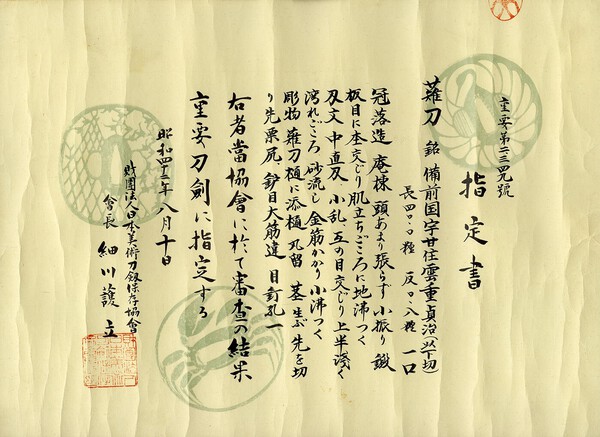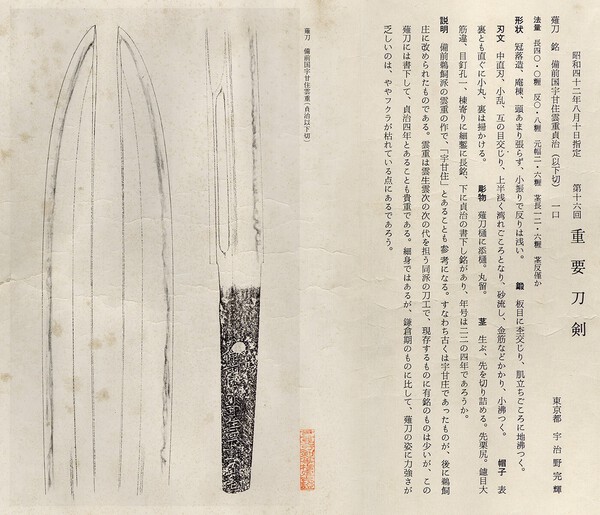
Natichu
Members-
Posts
112 -
Joined
-
Last visited
Everything posted by Natichu
-
What is the soul of your collection ?
Natichu replied to Benjamin's topic in General Nihonto Related Discussion
That certainly is a depth of knowledge that I imagine escapes most. Is there a particular smith then, knowledge of whom you'd put at the heart of your learning? Or a unifying theme among the smiths you have chosen to focus on? -
Though one wrinkle there - in the item I highlighted earlier, the nakago is described as ubu, but the setsumei makes clear it has been shortened. So while the blade hasn't been shortened or reshaped (and so likely is what it isn't a naoshi) with the nakago moved up, the tail of the tang was cut down. So while ubu, the tang is modified. Is it possible that is the case here?
-
Unless, of course, they're satisfied that despite modification to the nakago there has been no modification to the kissaki, and so leaving the kaeri, in which case they continue to refer to it as a naginata: https://www.aoijapan.com/wakizashibizen-kuni-ukai-ju-unjuthe-16th-nbthk-juyo-token/ Discussed here: Seeems like in the case you're proposing, if they were going to be duped surely they'd be more likely to continue to refer to blade as a naginata simpliciter, rather than as a balde that has undergone naoshi?
-
@Jacques, I don't think anyone above is arguing against the idea that in many, if not most, cases the naoshi process will mean the kaeri is lost. The rule of thumb is likely that one identifying feature of a naginata-naoshi is the fact the boshi is yakizume. However, what I think is being pointed out is this is not inevitable or universal, as there are examples showing exceptions to the rule. That is, blades that have been determined to be naginata-naoshi by a panel of experts with the blade in hand showing an (admittedly) small kaeri. Can I tell you what the process is that leads to this? Not in any meaningful way (we're both well aware of my very limited knowledge base), though my hypothesis would be this is likely possible based in the exact shape and geometry of the original blade, which could vary significantly while still being a naginata. But I would certainly defer to the opinion of the experts with blade in hand in saying clearly it is possible.
-
Very much appreciate the guide and all the work that went into it @Rivkin. And if you do go the newsletter route, sign me up!
-
I'd appreciate the other measures as well. Any papers?
-
While I'm too new to say in terms of the blades (which to me look somewhat tired/out of polish), I have to imagine you're going to be paying a significant premium for daisho koshirae even if it's only of middling quality (not saying this is a true daisho obviously, but rather a matched set of koshirae). Is that where you'd like to allocate your funds? No problem at all if it is, but I think it's just important to be aware of where the money is going to ensure you're getting the best bang for your buck. So to me the more important question (something I'm constantly trying to ask myself) is what is it that you want to buy, and why does this option fulfill whatever criteria it is that you've set? I think the usual advice to us beginners is to take our time, develop our knowledge base and delve into some specific areas of interests, and buy to further those interests. If all you want is antique blades in koshirae for an ok price, that isn't a problem or anything to be scoffed at. With hobbies sometimes it's nice just to feel like you have a bit of skin in the game, learn what you can, and see where that takes you. But I think it would help the more knowledgeable people here (read: definitely not me) in giving you advice to understand what it is you hope to get out of making a purchase.
-
I would add Token Komachi as well, plenty of swords in more reasonable price range, and Ms. Tsukada is excellent to deal with and speaks very good English. She is also highly responsive to emails. English listings here: https://www.toukenkomachi.com/index_en_tachi&katana.html If you're following for updates of new additions, best to do so in Japanese: https://www.toukenkomachi.com/index.html Yes, there is the concern around lead time from Japan, but it is what it is.
-
To that end, bonsai wire comes in long spools, is nicely malleable, and is often somewhat readily available. Likely to be much better to work with than a wire hanger.
-
Need help figure out the age and translation of this katana.
Natichu replied to bigscreen64's topic in Nihonto
A current auction listing for a TH wakizashi I assume is the smith in question, with a reasonably good picture of the nakago: https://www.sothebys.com/en/buy/auction/2025/important-Japanese-swords-and-armour-from-the-paul-l-davidson-collection/a-wakizashi-signed-izumi-no-kami-fujiwara-kunisada -
Thank you very much for that info. I hadn't heard of the book, so this was all news to me. While it does look like it's available digitally, I felt I'd prefer a physical copy so emailed Me-no-me. I heard back from them within the hour, and have a copy on the way to me shipped out the same day I ordered. Absolutely excellent experience thus far!
-
While I have no experience with him, I have often looked at the goods offered by @Artur DrogaMiecza here through his Flickr page: Some lovely koshirae seems to be available on occasion (including a wakizashi one I'm now sad I didn't pick up!)
-
Many thanks for the insight @Jussi Ekholm, I'll have to pick your brain at some point on the naginata front as at some point I'd like to pick one up! I'd have to agree, with such a short nakago it doesn't seem likely they'd still be viable as a polearm. Good to know that the terminology shifts, and it isn't a precise science as it were.
-
That was certainly my impression! I didn't see anything about the kissaki being reshaped in the setsumei, but I don't think my Japanese is up to the task one way or the other.
-
Thank you for the reminder on that point. It seems like one needs to simply get used to "the vibe of the thing" (for those that have watched The Castle), and take a blade on its own terms, rather than worrying too much about the words attached.
-
Even more interesting that both the nakago and kissaki have been reshaped (presumably to facilitate use as a wakizashi) and yet it still remains a naginata sans naoshi, as it were. Many thanks to you and @Geraint for shining some light on this!
-
Many thanks all. Clearly I have a lot of learning to do, but this is an interesting starting point as I have a strong interest in naginata and naginata-naoshi. @Jacques, are you able to provide any snippets of the zufu where this is listed as a wakizashi? Would that be a bit of a rarity for it to be listed differently than in the origami? I've never had the chance to see the zufu before (unless the page I've added above is from those books, in which case my apologies for misunderstanding!).
-
Good evening all, In continuing my reading and review of the usual sites we all undoubtedly frequent, I came across this piece on Aoi that raised a lot of questions in my mind relating to how the NBTHK categorizes things: https://www.aoijapan...th-nbthk-juyo-token/ Photo of the origami and juyo setsumei attached as well. So, as one can see the blade is currently in wakizashi koshirae. However, it has been categorized as a naginata, not a naginata-naoshi. If my Japanese is correct, the juyo setsumei indicates that the nakago is ubu, but also that it is cut down ("生ぶ、先を切り詰める"). The original mei remains. The kissaki has a kaeri and so as far as I understand it hasn't been reshaped. Questions I have for the members of the forum: 1) As this is now in wakizashi koshirae, with nakago modified to make that happen, why is this not a naginata-naoshi? Is this because the kissaki hasn't been reshaped? 2) What makes a nakago ubu? In this case, it has been cut down, and so it isn't unaltered. But I assume it hasn't been moved up the blade (though I've also seen blades with machiokuri listed as ubu). I appreciate all of this likely is me simply trying to be a bit more fixed in categories than is helpful. But the blade, fittings, and paperwork just stuck in my brain in odd ways, and thought it might make a good set of learning points for me. Any insight anyone can provide would be greatly appreciated!
-
Thank you very much for posting their response! Certainly the ryugo waisted style is an element of Tensho koshirae, but I would not have thought was enough on its own to fit the bill - Markus Sesko, for example, gives a few more what I would have thought defining characteristics. Tsuruta-san undoubtedly knows more than I do though, so appreciate the insight.
-
Many thanks Thomas, that is very much appreciated!
-
Not something that had occurred to me! I had assumed there was a real chance that I was simply wrong in my understanding, so felt more comfortable exposing my ignorance here rather than writing directly to Tsuruta-san (with whom I don't have any existing relationship) to ask for clarification.
-
Very interesting! Not something I've heard before, so very much appreciate it. I assume something along these lines would fit the bill? https://www.flickr.c...s/72177720321619029/
-
Certainly. Glad to know I wasn't totally out to punch thinking that didn't appear to be what I'd describe as a Tensho-style koshirae.
-
That was certainly my take, both the reference to Tensho and mine to Momoyama - stylistic rather than an age statement.






